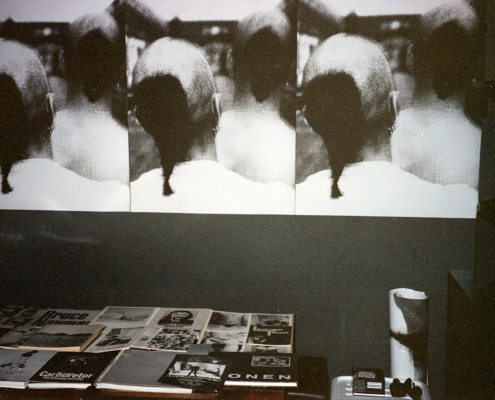This notion of conversation has deep roots in early AI theory and research, most notably evident in Alan Turing’s Turing test, where the ability of a machine to engage in a conversation is considered a measure of intelligence and it’s interesting to see how this conversation aspect of AI progresses alongside other facets, like gaming, military applications, or industrial uses. In Black Cloud, I particularly emphasized the personal communication aspect and the implications it might have on the broader development of AI.
In a recent interview you talked about how Sinofuturism originated from the realization that the values you were raised with, rooted in Chinese culture, align with the principles behind machine learning and artificial intelligence. You highlighted how the conventional portrayal of the future often appears dehumanized, prompting a subtle critique about using human standards to envision diverse futures. Which contemporary human aspects artificial intelligence or other technological creations will draw inspiration from in the years to come? How will these influences be incorporated into art?
With the idea of Sinofuturism I want to express my belief that the notion of humanity or humanism is not uniformly applied to all individuals; disparities are evident in various aspects and nowadays some humans are more human from a legal or ethical standpoint than others. In Sinofuturism, I contemplate the possibility that the dehumanized portrayal of Chinese workers, robots, and AI might be seen positively in contrast to the humanist perspective, which emphasizes individuality, rights, and subjectivity.
When I conceived Sinofuturism in 2016, I tried to think about the idea of non-humanism, a perspective related to a collective mind or hive, rather than individuality. I mean humanism is very much tied to individuality, as well as all the other legal and moral things, so I thought what would non-humanism be tied to? I speculated that AI or robots, instead of seeking individuality, could embrace their lack of it. This could mean that they don’t necessarily strive to possess a distinct identity, and in this context, their minds could potentially be transferred or downloaded elsewhere, and there could be something positive about existing as a non-individual entity. This concept diverges from humanist philosophies that grapple with questions of individual rights and integration into society, as seen in 20th-century politics, including communism and fascism. In parallel, this runs similarly in works such as Geomancer and AIdol. Various philosophies promote the idea of shedding ego and the illusion of self, notably in Buddhism and Taoism, and these philosophies suggest that the concept of individuality and human identity is illusory. In Taoism, individuals are seen as part of a larger natural force, while in Buddhism, individuality is viewed as a temporary phase in a broader cycle of existence. Considering this, I hypothesize that such philosophies about the non-self and collective identity might also resonate with AI or robots within the context of Sinofuturism.
Within this imagined landscape, I question the essence of art and its origins. To me, art is not merely about creating tangible objects but serves as a reflection of our world. I draw an analogy with landscape painting, where the artist observes the world and represents it through an idealized lens, blending elements from various sources to form a harmonious whole. Virtual worlds, in a similar manner, take shape as seamless collages, beautifully assembled yet comprising diverse components. For me, art is a means to construct entire fictional realities rather than just crafting individual objects. I envision a 21st-century version of landscape painting or a documentary that captures the essence of these fictional worlds. My role as an artist lies in framing these imagined realities, allowing them to exist on their own terms without direct intervention. In certain cultures, books that delve into fiction are also considered art, and I perceive my creative process akin to building a world within the medium of text. I find that my art serves as a mirror, reflecting ideas, emotions, and even entire narratives, acting as a container for these multifaceted expressions.
Are you working on any upcoming projects?
Sure! Last month, the Black Cloud Highway opened, and our next big project is an exhibition at the Las Art Foundation in Berlin, which is named Nox.
Nox is a play on words, representing both “knight” and also the name of a program developed by the AI company Farsight in the cinematic world of Geomancer and Idol. It stands for “Non-Human Excellence” and it represents a program dedicated to training self-driving cars. The exhibition in Berlin will feature a physical installation, simulating the training school for self-driving cars, alongside a video game where you take on the role of a trainee Farsight therapist for the AIs, basically you’ll be immersed in training the next generation of self-driving cars in the game. The exhibition is scheduled to start at the end of October, and apart from the installation and the game, we’re also planning to include some video works to complement the exhibition, though my focus is primarily on the installation side of things. And, of course, there will be a dedicated soundtrack as well.
Sound has always been an integral part of my art, and this project won’t be an exception.
 https://www.nastymagazine.com/wp-content/uploads/2022/02/th-nasty-mag-.jpg
640
640
admin
https://www.nastymagazine.com/wp-content/uploads/2015/02/new-logo-basker-WHITE4.png
admin2022-02-01 11:09:152022-02-07 14:47:41Tom Hancocks / Furniture From Outer Space
https://www.nastymagazine.com/wp-content/uploads/2022/02/th-nasty-mag-.jpg
640
640
admin
https://www.nastymagazine.com/wp-content/uploads/2015/02/new-logo-basker-WHITE4.png
admin2022-02-01 11:09:152022-02-07 14:47:41Tom Hancocks / Furniture From Outer Space












